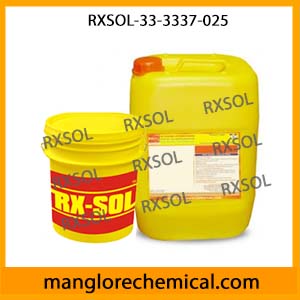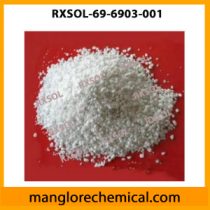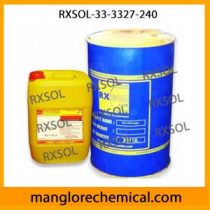Product Name
Antiscalant / Antifoulant – Corrosion Inhibitor 704
Part Number
RXSOL-33-3337-025
Company Details:
RX MARINE INTERNATIONAL
105, A wing , BSEL , TECH PARK.
VASHI ,NEW BOMBAY 400703 INDIA
Phone
+91 22 65113333 / 5555 / 9999
Fax
+91 22 2781 1318 :::AOH :0091 9821214367
Email
123@rxmarine.com
Website
http://www.rxmarine.com
Name of Substance
Cas Number
EC Number
Wight %
Disodium phosphonate
13708-85-5
——
2 – 10%
Non Hazardous Ingirdent
90 – 95%
Designates that a specific chemical identity and/or percentage of composition has been withheld as a trade secret.
Signal Word
Warning
Hazard Statements
May be corrosive to metals.
Precautionary statements – prevention
Avoid release to the environment.
Wear protective gloves/ protective clothing/ eye protection/ face protection.
Precautionary statements – response
IF SWALLOWED: Rinse mouth. Do NOT induce vomiting.
IF ON SKIN: Wash with plenty of soap and water.
IF INHALED: Remove victim to fresh air and keep at rest in a position comfortable for breathing.
IF IN EYES: Rinse cautiously with water for several minutes. Remove contact lenses, if present and easy to do. Continue rinsing.
Eye Contact
Rinse with water. Get medical attention if irritation develops and persists.
Skin Contact
In case of contact, immediately flush skin with plenty of water. Cover the irritated skin with an emollient. Remove contaminated clothing and shoes. Cold water may be used.Wash clothing before reuse. Thoroughly clean shoes before reuse. Get medical attention.
Inhalation:
Move to fresh air. If breathing is difficult, give oxygen. Get medical attention immediately if symptoms occur.
Ingestion:
Do not induce vomiting. Obtain medical attention.If vomiting occurs, lean patient forward or place on left side (head-down position, if possible) to maintain open airway and prevent aspiration.
Notes to Physician
Treat symptomatically
Flammability
Non-flammable.
Flash Point
Not applicable.
Suitable extinguishing media
No information available
Hazardous combustion
products
During fire, gases hazardous to health may be formed.
Protective Equipment
In case of fire and/or explosion do not breathe fumes. Use standard firefighting procedures and consider the hazards of other involved materials. Move containers from fire area if you can do so without risk. Cool containers / tanks with water spray.
Specific Hazards Arising from the Chemical
Not considered to be a significant fire risk.
Small Spillage
Wipe up with absorbent material (e.g. cloth, fleece). Clean surface thoroughly to remove residual contamination.Finish cleaning by spreading water on the contaminated surface and dispose of according to local and regional authority requirements
Large Spillage
Large Spills: Stop the flow of material, if this is without risk. Dike the spilled material, where this is possible. Absorb spillage to prevent material damage. Use a non-combustible material like vermiculite, sand or earth to soak up the product and place into a container for later disposal. Following product recovery, flush area with water.
Personal Protection
Keep unnecessary personnel away. Keep people away from and upwind of spill/leak. Wear appropriate protective equipment and clothing during clean-up. Do not touch damaged containers or spilled material unless wearing appropriate protective clothing. Ensure adequate ventilation. Local authorities should be advised if significant spillages cannot be contained. For personal protection, see section 8.
Enviromental Precaution
Do not let product enter drains.
Methods and materials for
containment and cleaning
Cover drains. Collect, bind, and pump off spills. Observe possible material restrictions (see sections 7 and 10). Take up dry. Dispose of properly. Clean up affected area. Avoid generation of dusts
Handling
Avoid prolonged exposure. Provide adequate ventilation. Wear appropriate personal protective equipment. Observe good industrial hygiene practices. Use care in handling/storage.In case of insufficient ventilation, wear suitable respiratory equipment. If ingested, seek medical advice immediately and show the container or the label. Keep away from incompatibles such as oxidizing agents,.
Storage
Store in a cool, dry place out of direct sunlight. Keep only in the original container. Store away from incompatible materials (see Section 10 of the SDS). Store in accordance with local/regional/national/international regulation.
Advice on general occupational hygiene
Advice on safe handling Observe label precautions. Change contaminated clothing. Wash hands after working with substance.
Engineering Control
Provide exhaust ventilation or other engineering controls to keep the airborne concentrations of vapors below their respective threshold limit value. Ensure that eyewash stations and safety showers are proximal to the work-station location.
Personal Protection
Eye/face Protection : Wear appropriate protective eyeglasses or chemical safety goggles as described by OSHA's eye and face protection regulations in 29 CFR 1910.133 or European Standard EN166.
Skin and body protection : Wear appropriate protective gloves and clothing to prevent skin exposure. Respiratory Protection : Follow the OSHA respirator regulations found in 29 CFR 1910.134 or European Standard EN 149. Use a NIOSH/MSHA or European Standard EN 149 approved respirator exposure limits are exceeded or if irritation or other symptoms are experienced.
Other Protection Measure
Handle in accordance with good industrial hygiene and safety practice.
Exposure Limit
No exposure limits noted for ingredient(s).
General hygiene considerations
Always observe good personal hygiene measures, such as washing after handling the material and before eating, drinking, and/or smoking. Routinely wash work clothing and protective equipment to remove contaminants.
Gloves Suit
Form
Liquid
Colour
Clear
Odour
Slight amine
Odor Threshold
No Information Available
pH
11.1 – 11.3
Freezing Point
-5 °C
Boiling Point
102°C
Flash Point
Not Applicable
Evaporation Rate
< 1 (Ether = 1)
Flammability (solid, gas)
No Data Available
Explosive limits
No Data Available
Vapour pressure
18 mm Hg
Vapor pressure temp
70 °F (21 °C)
Vapour Density
< 1 (Air = 1)
Specific Gravity
1.13 – 1.14 at 25 °C
Partition coefficient
No data available
Explosive properties
None
Solubility
Soluble in water
Ignition temperature
Not available
Recativity
May be corrosive to metals.
Stability
Product is stable.
hazardous Decomposition
No hazardous decomposition products are known.
Conditions to avoid
Strong Heating
Incompatible materials
Strong oxidizing agents. Metals
Hazardous Polymerization
Hazardous polymerization does not occur.
Rout Of Entry
Absorbed through skin. Eye contact. Inhalation. Ingestion.
Toxicity to Animal
Dermal LD50 Rabbit > 5000 mg/kg, (Calculated according to GHS additivity formula)
Inhalation LC50 Rat > 5 mg/l, 4 Hour, (Calculated according to GHS additivity formula)
Oral LD50 Rat > 5000 mg/kg, (Calculated according to GHS additivity formula)
Toxic Effects on Humans
Inhalation : No adverse effects due to inhalation are expected. Skin contact : Prolonged or repeated contact may cause transient irritation. Eye contact : Direct contact with eyes may cause temporary irritation. Ingestion : Expected to be a low ingestion hazard.
Special Remarks on other Toxic Effects on Humans:
Skin corrosion/irritation : Prolonged skin contact may cause temporary irritation. Serious eye damage/eye irritation : Direct contact with eyes may cause temporary irritation.Respiratory or skin sensitization : Respiratory sensitization This product is not expected to cause respiratory sensitization. Skin sensitization : This product is not expected to cause skin sensitization. No data available to indicate product or any components present at greater than 0.1% are mutagenic or genotoxic.
Germ cell mutagenicity : Carcinogenicity This product is not considered to be a carcinogen by IARC, ACGIH, NTP, or OSHA.
Eco Toxicity
Not Available
COD and BOD 5
COD (mgO2/g) 65 (calculated data)
TOC (mg C/g) 22 (calculated data)
Products of Biodegradation:
No Information available
Mobility in soil
No Information available
Results of PBT and vPvB assessment
Substance(s) in the mixture do(es) not meet the criteria for PBT or vPvB .
Other adverse effects
Discharge into the environment must be avoided.
Waste treatment Method
Waste material must be disposed of in accordance with the national and local regulations. Leave chemicals in original containers. No mixing with other waste. Handle uncleaned containers like the product itself
DOT
UN Number
UN 3267
Proper shipping name
CORROSIVE LIQUID, BASIC, ORGANIC, N.O.S. (PHOSPHONIC ACID, [NITRILOTRIS(METHYLENE)]TRIS, SODIUM SALT)
Hazard Class
8
Packing group
III
TDG
UN Number
UN 3267
Proper shipping name
CORROSIVE LIQUID, BASIC, ORGANIC, N.O.S. (PHOSPHONIC ACID, [NITRILOTRIS(METHYLENE)]TRIS, SODIUM SALT)
Hazard Class
8
Packing group
III
IATA
UN Number
UN 3267
Proper shipping name
CORROSIVE LIQUID, BASIC, ORGANIC, N.O.S. (PHOSPHONIC ACID, [NITRILOTRIS(METHYLENE)]TRIS, SODIUM SALT)
Hazard Class
8
Packing group
III
IMDG/IMO
UN Number
UN 3267
Proper shipping name
CORROSIVE LIQUID, BASIC, ORGANIC, N.O.S. (PHOSPHONIC ACID, [NITRILOTRIS(METHYLENE)]TRIS, SODIUM SALT)
Hazard Class
8
Packing group
III
Fedral and State Regulation
This product is a "Hazardous Chemical" as defined by the OSHA Hazard Communication Standard, 29 CFR 1910.1200.
Other Regulation
Not Regulated
WHMIS (Canada)
Not Regulated
DSCL (EEC)
R36- Irritating to eyes. S2- Keep out of the reach of children. S24/25- Avoid contact with skin and eyes. S46- If swallowed, seek medical advice immediately and show this container or label.
HMIS
Health Hazard
: 1
Fire Hazard
: 0
Reactivity
: 0
Personal Protection
: H
Fire :
Health Hazard
: 1
Fire Hazard
: 0
Reactivity
: 0
Specific Hazard
: H
Other Information
The information above is believed to be accurate and represents the best information currently available to us. However, we make no warranty of merchantability or any other warranty, express or implied, with respect to such information, and we assume no liability resulting from its use. Users should make their own investigations to determine the suitability of the information for their particular purposes. In no event shall be liable for any claims, losses, or damages of any third party or for lost profits or any special, indirect, incidental, consequential or exemplary damages, howsoever arising, even if Rx Marine International has been advised of the possibility of such damages.
|





Reviews
There are no reviews yet.